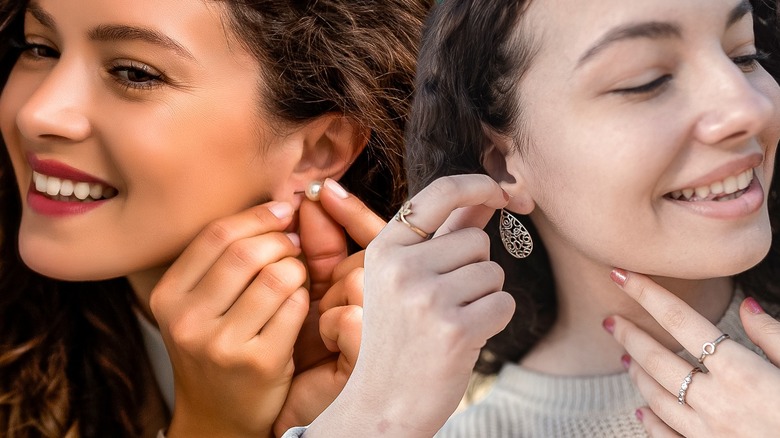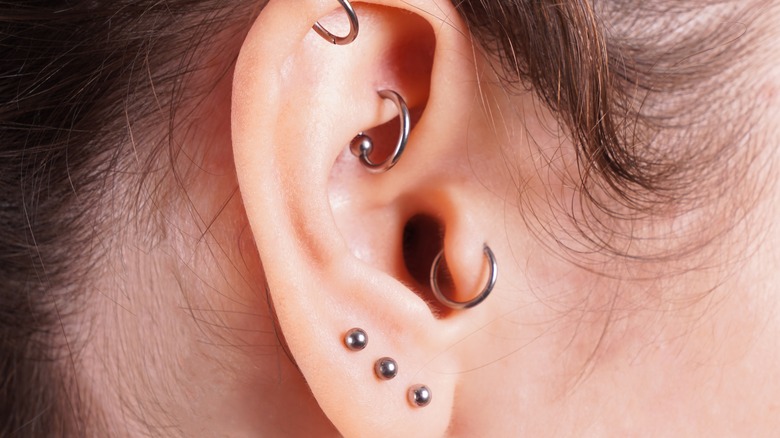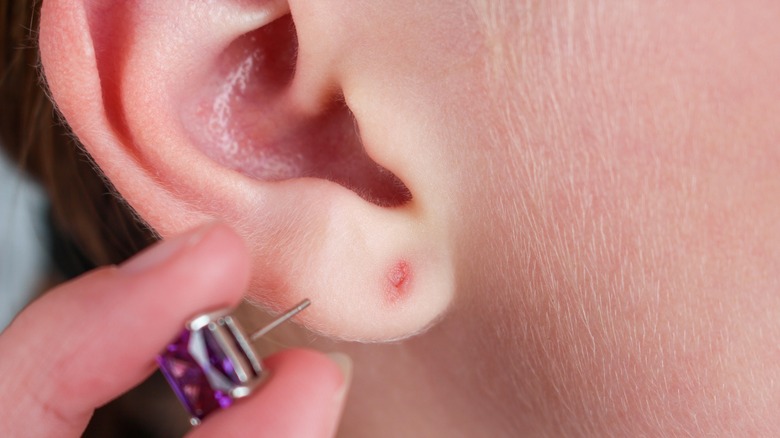When Can You Really Change Your Earrings After A Fresh Piercing?
Getting a new ear piercing is the perfect way to freshen up your look. From standard lobe piercings to snug, tragus, and anti-tragus varieties, there's a kind of earring for every style, whether you lean towards an edgy or minimal aesthetic. However, before you can start wearing new jewelry in your fresh piercing, you have to wait for it to heal.
For most standard lobe piercings, many experts recommend waiting at least six to eight weeks before changing earrings (via Jewellery Box). Some professionals in the field actually suggest waiting even longer; the team at Studs, for example, advise that most ear piercings will need a minimum of four months to completely heal. If you try to wear new jewelry in an ear piercing before it's fully healed, you could end up irritating the wound, which may result in infection. You could also find that the hole closes up again, which is particularly annoying after you've survived the more painful kinds of ear perforations (yes, rook piercings, we mean you).
However, while the standard advice is waiting a minimum of six weeks, the reality is everybody will heal at a different rate. You may find that you get to two, or even four, months after getting your ear pierced, and it's still not ready for new jewelry. To avoid irritation and infection, you should always listen to your body over the generic recommended timeframes.
Healing time depends on several factors
One of the most significant factors that affects the healing time of an ear piercing is where in the ear it's located. Studs, whose advice seems to err more on the side of caution than other sources, states that you will likely be able to "downsize" your standard lobe earring between two and three months after getting pierced. However, you won't be able to move to "hoops" or "fashion jewelry" until full healing has taken place. This can take anywhere from four to six months, or more.
Meanwhile, tragus, conch, and helix piercings often take between six and nine months to fully heal. For daith, rook, and anti-tragus piercings to heal, you're looking at eight months to a year, or more.
Additionally, the general state of your health can impact how long your piercing takes to heal, along with how you're caring for it. If you aren't regularly cleaning the piercing, for example, it may get infected, which can prolong your healing time. According to Dr. Piercing, you can help your piercing to heal as quickly as possible by cleaning the site every day with saline solution and wearing surgical-grade stainless steel earrings immediately after your piercing.
Signs that your piercing isn't healed
Even after you've waited the recommended timeframe for your piercing to heal, watch out for signs that it's not ready yet before changing your earrings. One of the clearest signs that it hasn't healed is visible discharge or inflammation, which can present as redness in the ear, per Blomdahl.
As Piercing HQ notes, you can generally expect the site to hurt if you accidentally knock it during the healing period, or if it gets infected. But when it's healed, the hole itself will be even rather than jagged, and you'll be able to touch the earring without any pain.
Also pay attention to how easily you can move the earring already in your ear. Your piercing is likely still in the healing stage if it feels quite tight or it's difficult to move. If you aren't sure whether your piercing has healed or not, you could always return to your piercer and ask them to assess it for you. As changing your earring too early can lead to complications that could set your healing way back, it's better to be safe than sorry.


